Klystrons and Storage Rings: Smashing Atoms at Stanford
Klystrons and Storage Rings: Smashing Atoms at Stanford
On Friday D. and I took a tour of SLAC National Accelerator Laboratory. SLAC, or Stanford Linear Accelerator Center, is where Stanford University conducts research into high-energy particle physics. High-energy particle physics is smashing atoms at 99.9999999% light speed and looking at the results of the collision. High-energy particle physicists want to know things like, what are the smallest building blocks from which all matter is made? And, what are the interactions between them that govern how they combine and decay? Brainy stuff.

On our way in, we pass by the Kavli Institute for Particle Astrophysics and Cosmology, or KIPAC, with its sculpture in front. Maybe it represents an astrophysical particle.

We head to the auditorium to watch a slide show before beginning the tour.

We poke around in the visitor's center prior to the presentation. Here's a klystron, the accelerator part of the system.

The klystrons at SLAC are similar to the microwave generators that power microwave ovens, but are about 60,000 times more powerful than a kitchen microwave. In a klystron, the electron gun produces a flow of electrons. The electrons travel through bunching cavities, which regulate their speed so that they arrive in bunches at the output cavity. The bunches of electrons excite microwaves in the klystron's output cavity. The microwaves flow into a waveguide, which transports them to the accelerator. The electrons are then absorbed in a beam stop. (Pay attention, this will be on the mid-term!)
Magnets along the accelerator direct and focus the electron beam.

A cutaway of a vertex detector. Its multiple layers measure the location of outgoing charged particles as they pass through it.

A drift chamber. Its 35,000 fine wires detect the positions of charged particles at several points along the track. The curvature of the track in the magnetic field reveals the particle's momentum. That helps high-energy particle physicists to determine the particle's charge and mass.


This device is a cosmic ray detector. It measures one type of cosmic ray called a muon. Most cosmic rays decay or are absorbed in the atmosphere, but some muons make it to Earth's surface. The detector has sensors (the black rectangles) along 3 axes, and every time a muon hits a detector, the device beeps, sounding with a different tone for each axis. (We hear a steady pulse of tones, one or 2 per second, while we are there.)

Twice as many muons are detected along the vertical axis compared to the oblique axis, and twenty times as many compared to the horizontal axis (since there is more atmosphere to travel through at those angles, more muons decay before reaching the sensor).
When the tunnel for the accelerator was being dug in the 1960s, they unearthed a fossil.

Paleoparadoxia was an herbivorous marine mammal living in the shallow seas around the northern Pacific Ocean 10 to 20 million years ago. It resembles a hippopotamus.

Oh hai!

(Yes, it's behind glass; sorry about the reflections.)
Lower forelimb.

Some of the stuff SLAC does.

During the presentation in the auditorium, we learn a lot of stuff. For example, the accelerator is the longest building in the world (2 miles), and it keeps an electron beam tightly focused in a one-centimeter-diameter channel along its entire length. And it takes a lot of juice to smash atoms. SLAC's operation is funded by the Department of Energy, and its annual budget is about $300,000,000. Ten percent of that amount goes to power the facility. That's $2.5 million per month to keep the lights on, the coffee warm and the klystrons fired up. How big is your monthly energy bill?
After the slide show, we board a bus to see the klystron gallery, the part of the accelerator that is visible above ground (the actual beamline is 30 feet below). The overpass in the pic is Interstate 280. The accelerator keeps going beyond that for another 8000 feet.

Certain sections are set aside for visitors.

Hmm, looks like I'll have to put them in touch with the Apostrophe Protection Society.
There are warning signs outside the klystron gallery.


Inside the klystron gallery.


The yellow sign on it reads: "CAUTION This equipment produces ionizing radiation when energized. RADIATION AREA Authorized personnel only." You can't smash atoms without producing some radiation.
There are other kinds of equipment as well.

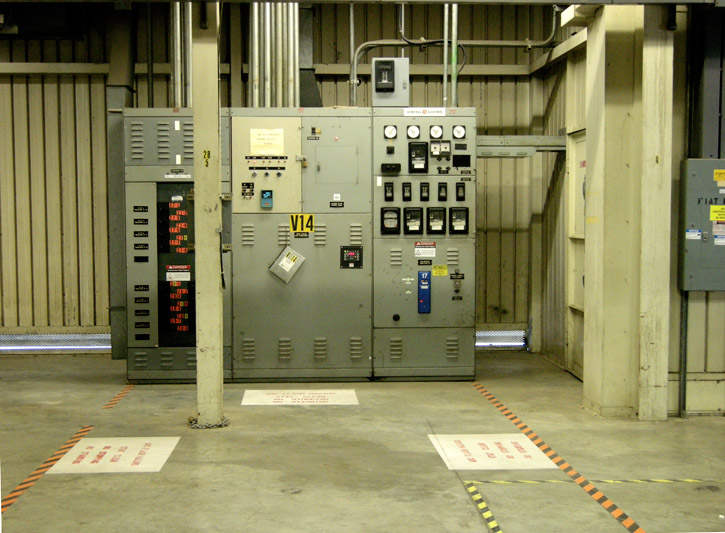
There are all kinds of warning signs everywhere.
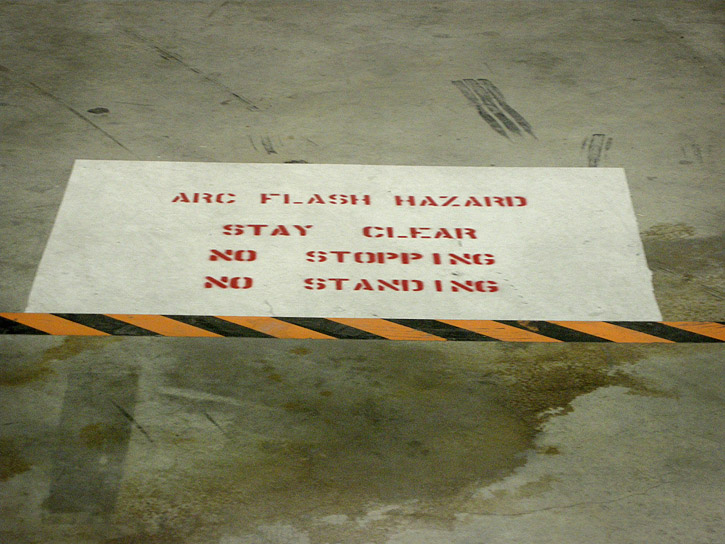



(I can only assume it means non-radiologically controlled area.
In other words, if you stand here you won't go home glowing in the dark.)
It is surprisingly hot in the klystron gallery. It is also very noisy. Earplugs are provided.

Inside the klystron gallery.


There is a klystron every 40 feet up and down the entire two miles. (After all, those electrons aren't going to accelerate themselves.)
Next we get back aboard the bus to visit the Linac Coherent Light Source (LCLS) control room. The LCLS is an X-ray laser that can capture images of atoms and molecules in motion, probing the ultra-small and capturing the ultra-fast.
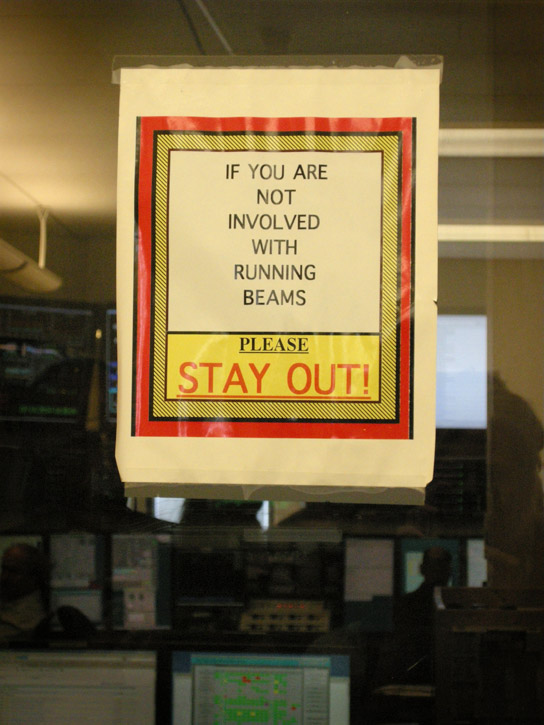
It's complicated in there.
A few of the challenges accelerator operators face include 24/7 monitoring the cooling system to keep the metal accelerator structure from expanding or contracting (which would change the frequency of the microwave resonance, and you can't have that if you want to smash atoms properly); maintaining a high vacuum 24/7 throughout the entire klystron and accelerating structure (over three miles of pipes must be kept pumped out to one one-billionth of atmospheric pressure); correcting the timing of the phase of every klystron 24/7 (so there are no phase mis-matches along the two-mile stretch of klystrons); and monitoring the beam 24/7 at many points along the accelerator, using a variety of complex devices (many of which produce displays on the screens in the control room).

Hey, it's high-energy particle physics -- it's gonna be complicated.
A key system is used to prevent accidents. To access any section of the accelerator a key is needed, and removing a key from the panel shuts down that section so entry can proceed safely and no one goes home glowing in the dark.

High-energy particle physicists are super geniuses.

High-energy particle physicists are snappy dressers.
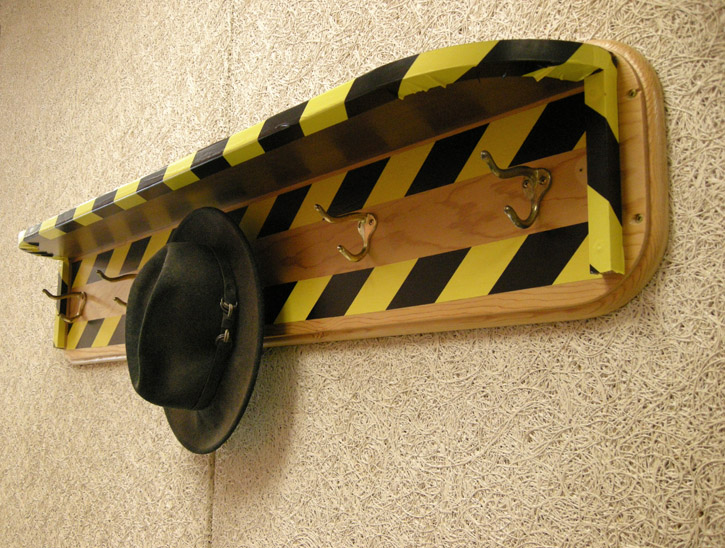
High-energy particle physicists have a sense of humor.

High-energy particle physicists make good money (apparently).
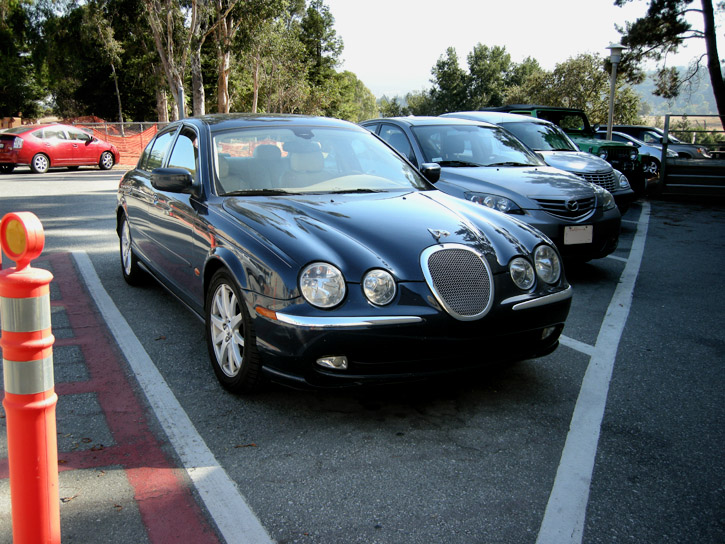
Our bus suffers a mishap, getting stuck under a pipe connected to the low-conductivity water cooling system, outside the LCLS control room. (No injuries.)

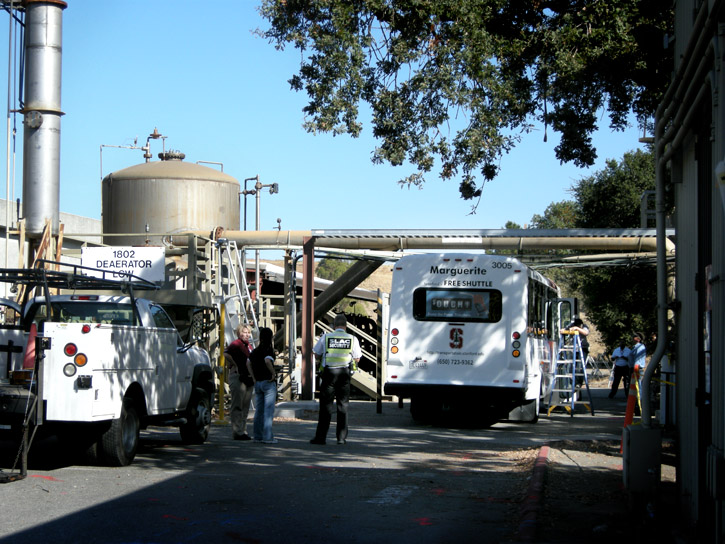
LCW (Low-Conductivity Water) cooling plant.


Accelerators use low-conductivity water for cooling the copper accelerator chamber and focusing magnets, because they don't want a stray electrical charge to muck up the experiments or damage the equipment.
We have time to look around at some of the equipment and stuff out here.
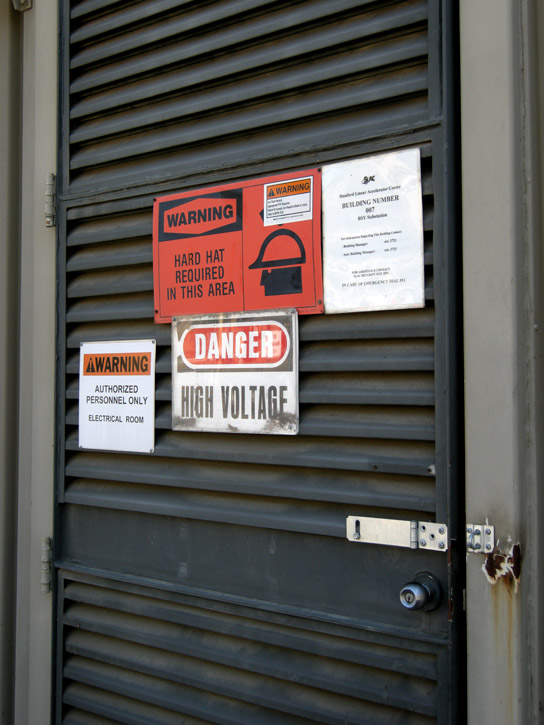



The various pieces of equipment hum at different pitches, harmonizing with each other. It is pleasant to listen to.
This looks like the nitrogen cylinders have their own guard, but he's actually overseeing the stuck bus, out of the frame on the left.
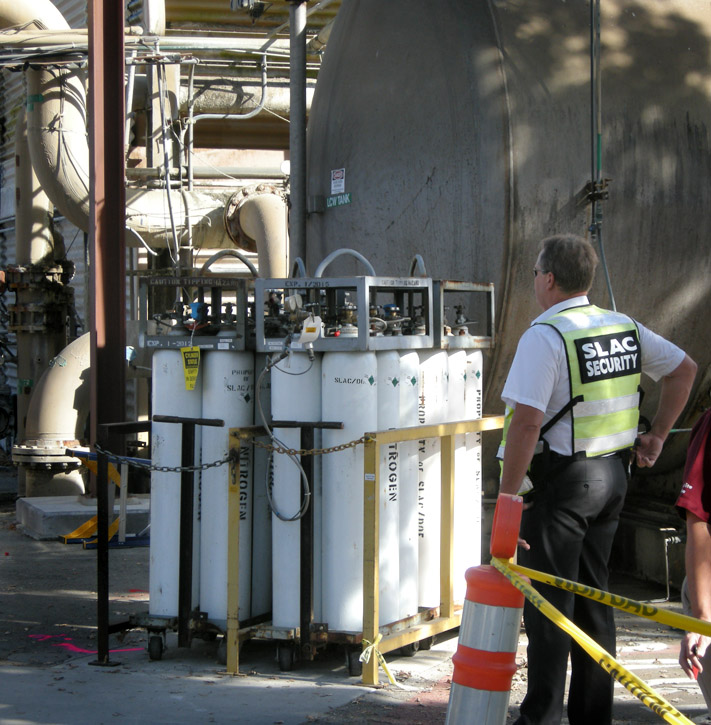
Someone from maintenance arrives to cut the bus free.

Rather than hang around and wait for a replacement bus to take us back to the parking lot, we opt to walk back to the car. (There is nowhere to sit and my back can't handle standing around with no walking.) We soon find ourselves on top of the accelerator. We keep seeing groups of huge blocks of concrete chained together.

Huge concrete blocks are heavy. Why chain them together?
Oh.

We pass by the facility's air conditioning plant, inside which an eternal rain falls.


Here's an old klystron made into a statue on the lab's campus.

They've got their branding down.
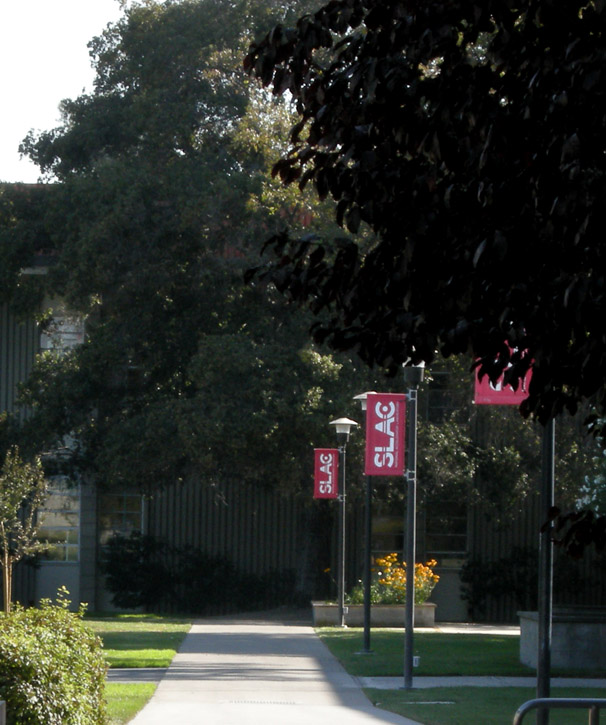



❧ ❧ ❧ ❧ ❧ ❧ ❧ ❧ ❧ ❧ ❧ ❧ ❧ ❧ ❧ ❧ ❧ ❧ ❧ ❧ ❧ ❧ ❧ ❧ ❧ ❧ ❧
And here are D.'s pics, mostly from the slide show presentation prior to the actual tour.
A sculpture in a redwood grove across from the auditorium.

This end of the drift chamber bristles with resistors.

Paleoparadoxia.

Cross-section of the accelerator, where the electrons go whizzing along. The two-mile long accelerator is made from over 80,000 copper discs and cylinders.


A magnetron from an ordinary kitchen microwave. It is minute compared to the huge klystrons in the accelerator.

"Why accelerate?" the slide show asks.

Because, in spite of all those brains at Stanford, there's a lot of stuff they still don't understand!
An overview of the main linac, or linear accelerator.

The location of the PEP ring, where the beam can be stored between experiments.
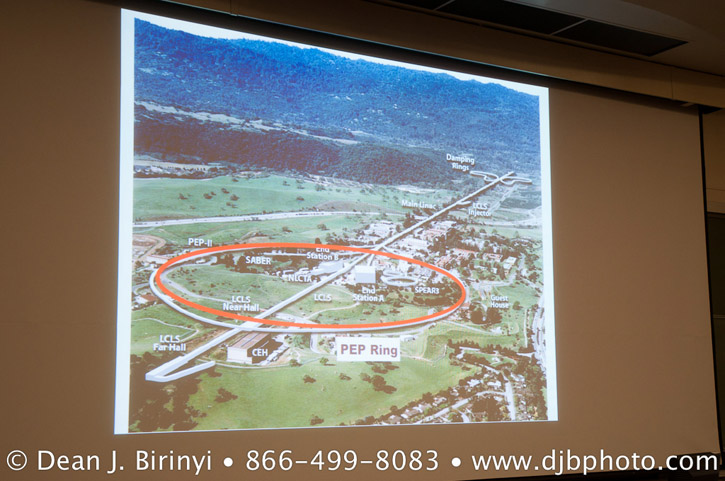
The location of the LCLS, where they do the X-ray laser stuff.

The location of KIPAC, or the Kavli Institute for Particle Astrophysics and Cosmology.
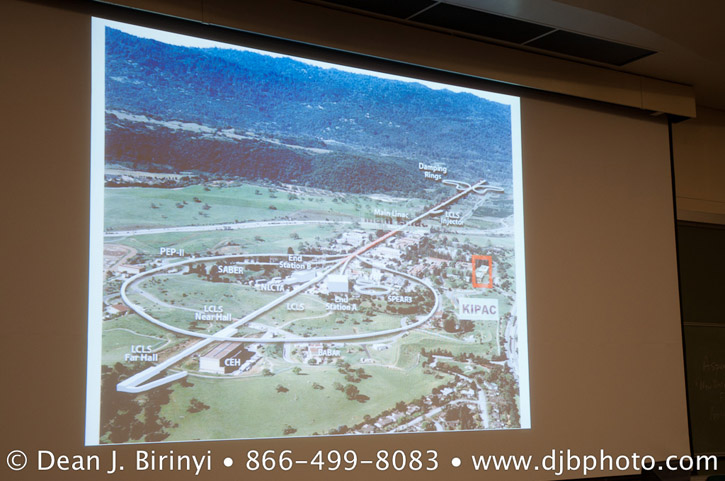
Info about the main linac.



SPEAR ring info slides.



LCLS info slides.


KIPAC info slides.




Inside the klystron visitor gallery, we see a sample of how the wave guides from the klystrons join into the accelerator.
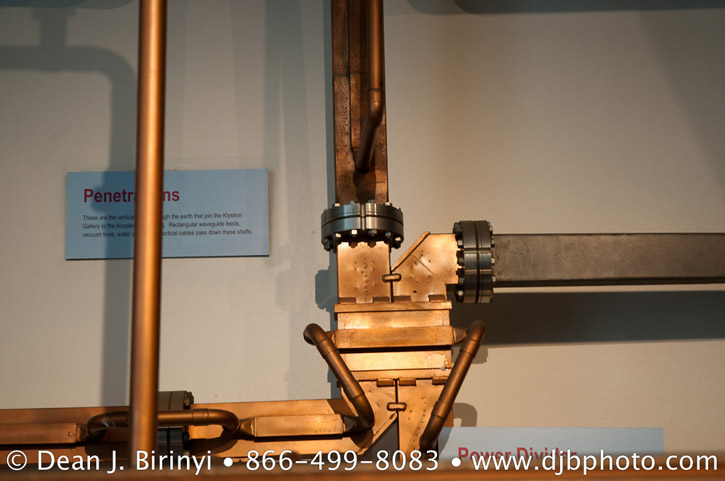
We see how the accelerator can be hand-adjusted section by section (which has to be done after every earthquake, even though the whole thing is bolted to bedrock).
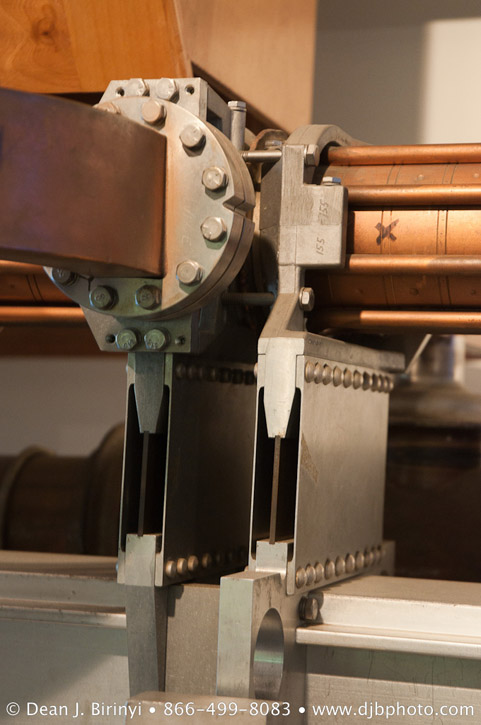
We see a sample of the cooling pipes for the accelerator.

We see how the beam can be manually aligned, using a Fresnel lens.

Looking along the actual klystron gallery.

Part of a klystron, the thing that makes those electrons go really, really, really fast.

.
On Friday D. and I took a tour of SLAC National Accelerator Laboratory. SLAC, or Stanford Linear Accelerator Center, is where Stanford University conducts research into high-energy particle physics. High-energy particle physics is smashing atoms at 99.9999999% light speed and looking at the results of the collision. High-energy particle physicists want to know things like, what are the smallest building blocks from which all matter is made? And, what are the interactions between them that govern how they combine and decay? Brainy stuff.

On our way in, we pass by the Kavli Institute for Particle Astrophysics and Cosmology, or KIPAC, with its sculpture in front. Maybe it represents an astrophysical particle.


We head to the auditorium to watch a slide show before beginning the tour.

We poke around in the visitor's center prior to the presentation. Here's a klystron, the accelerator part of the system.

The klystrons at SLAC are similar to the microwave generators that power microwave ovens, but are about 60,000 times more powerful than a kitchen microwave. In a klystron, the electron gun produces a flow of electrons. The electrons travel through bunching cavities, which regulate their speed so that they arrive in bunches at the output cavity. The bunches of electrons excite microwaves in the klystron's output cavity. The microwaves flow into a waveguide, which transports them to the accelerator. The electrons are then absorbed in a beam stop. (Pay attention, this will be on the mid-term!)
Magnets along the accelerator direct and focus the electron beam.

A cutaway of a vertex detector. Its multiple layers measure the location of outgoing charged particles as they pass through it.

A drift chamber. Its 35,000 fine wires detect the positions of charged particles at several points along the track. The curvature of the track in the magnetic field reveals the particle's momentum. That helps high-energy particle physicists to determine the particle's charge and mass.


This device is a cosmic ray detector. It measures one type of cosmic ray called a muon. Most cosmic rays decay or are absorbed in the atmosphere, but some muons make it to Earth's surface. The detector has sensors (the black rectangles) along 3 axes, and every time a muon hits a detector, the device beeps, sounding with a different tone for each axis. (We hear a steady pulse of tones, one or 2 per second, while we are there.)

Twice as many muons are detected along the vertical axis compared to the oblique axis, and twenty times as many compared to the horizontal axis (since there is more atmosphere to travel through at those angles, more muons decay before reaching the sensor).
When the tunnel for the accelerator was being dug in the 1960s, they unearthed a fossil.

Paleoparadoxia was an herbivorous marine mammal living in the shallow seas around the northern Pacific Ocean 10 to 20 million years ago. It resembles a hippopotamus.

Oh hai!

(Yes, it's behind glass; sorry about the reflections.)
Lower forelimb.

Some of the stuff SLAC does.

During the presentation in the auditorium, we learn a lot of stuff. For example, the accelerator is the longest building in the world (2 miles), and it keeps an electron beam tightly focused in a one-centimeter-diameter channel along its entire length. And it takes a lot of juice to smash atoms. SLAC's operation is funded by the Department of Energy, and its annual budget is about $300,000,000. Ten percent of that amount goes to power the facility. That's $2.5 million per month to keep the lights on, the coffee warm and the klystrons fired up. How big is your monthly energy bill?
After the slide show, we board a bus to see the klystron gallery, the part of the accelerator that is visible above ground (the actual beamline is 30 feet below). The overpass in the pic is Interstate 280. The accelerator keeps going beyond that for another 8000 feet.

Certain sections are set aside for visitors.

Hmm, looks like I'll have to put them in touch with the Apostrophe Protection Society.

There are warning signs outside the klystron gallery.


Inside the klystron gallery.


The yellow sign on it reads: "CAUTION This equipment produces ionizing radiation when energized. RADIATION AREA Authorized personnel only." You can't smash atoms without producing some radiation.
There are other kinds of equipment as well.


There are all kinds of warning signs everywhere.




(I can only assume it means non-radiologically controlled area.

In other words, if you stand here you won't go home glowing in the dark.)
It is surprisingly hot in the klystron gallery. It is also very noisy. Earplugs are provided.

Inside the klystron gallery.


There is a klystron every 40 feet up and down the entire two miles. (After all, those electrons aren't going to accelerate themselves.)
Next we get back aboard the bus to visit the Linac Coherent Light Source (LCLS) control room. The LCLS is an X-ray laser that can capture images of atoms and molecules in motion, probing the ultra-small and capturing the ultra-fast.

It's complicated in there.
A few of the challenges accelerator operators face include 24/7 monitoring the cooling system to keep the metal accelerator structure from expanding or contracting (which would change the frequency of the microwave resonance, and you can't have that if you want to smash atoms properly); maintaining a high vacuum 24/7 throughout the entire klystron and accelerating structure (over three miles of pipes must be kept pumped out to one one-billionth of atmospheric pressure); correcting the timing of the phase of every klystron 24/7 (so there are no phase mis-matches along the two-mile stretch of klystrons); and monitoring the beam 24/7 at many points along the accelerator, using a variety of complex devices (many of which produce displays on the screens in the control room).

Hey, it's high-energy particle physics -- it's gonna be complicated.
A key system is used to prevent accidents. To access any section of the accelerator a key is needed, and removing a key from the panel shuts down that section so entry can proceed safely and no one goes home glowing in the dark.

High-energy particle physicists are super geniuses.

High-energy particle physicists are snappy dressers.

High-energy particle physicists have a sense of humor.

High-energy particle physicists make good money (apparently).

Our bus suffers a mishap, getting stuck under a pipe connected to the low-conductivity water cooling system, outside the LCLS control room. (No injuries.)


LCW (Low-Conductivity Water) cooling plant.


Accelerators use low-conductivity water for cooling the copper accelerator chamber and focusing magnets, because they don't want a stray electrical charge to muck up the experiments or damage the equipment.
We have time to look around at some of the equipment and stuff out here.




The various pieces of equipment hum at different pitches, harmonizing with each other. It is pleasant to listen to.
This looks like the nitrogen cylinders have their own guard, but he's actually overseeing the stuck bus, out of the frame on the left.

Someone from maintenance arrives to cut the bus free.

Rather than hang around and wait for a replacement bus to take us back to the parking lot, we opt to walk back to the car. (There is nowhere to sit and my back can't handle standing around with no walking.) We soon find ourselves on top of the accelerator. We keep seeing groups of huge blocks of concrete chained together.

Huge concrete blocks are heavy. Why chain them together?

Oh.


We pass by the facility's air conditioning plant, inside which an eternal rain falls.


Here's an old klystron made into a statue on the lab's campus.

They've got their branding down.




❧ ❧ ❧ ❧ ❧ ❧ ❧ ❧ ❧ ❧ ❧ ❧ ❧ ❧ ❧ ❧ ❧ ❧ ❧ ❧ ❧ ❧ ❧ ❧ ❧ ❧ ❧
And here are D.'s pics, mostly from the slide show presentation prior to the actual tour.
A sculpture in a redwood grove across from the auditorium.

This end of the drift chamber bristles with resistors.

Paleoparadoxia.

Cross-section of the accelerator, where the electrons go whizzing along. The two-mile long accelerator is made from over 80,000 copper discs and cylinders.


A magnetron from an ordinary kitchen microwave. It is minute compared to the huge klystrons in the accelerator.

"Why accelerate?" the slide show asks.

Because, in spite of all those brains at Stanford, there's a lot of stuff they still don't understand!
An overview of the main linac, or linear accelerator.

The location of the PEP ring, where the beam can be stored between experiments.

The location of the LCLS, where they do the X-ray laser stuff.

The location of KIPAC, or the Kavli Institute for Particle Astrophysics and Cosmology.

Info about the main linac.



SPEAR ring info slides.



LCLS info slides.


KIPAC info slides.




Inside the klystron visitor gallery, we see a sample of how the wave guides from the klystrons join into the accelerator.

We see how the accelerator can be hand-adjusted section by section (which has to be done after every earthquake, even though the whole thing is bolted to bedrock).

We see a sample of the cooling pipes for the accelerator.

We see how the beam can be manually aligned, using a Fresnel lens.

Looking along the actual klystron gallery.

Part of a klystron, the thing that makes those electrons go really, really, really fast.

.